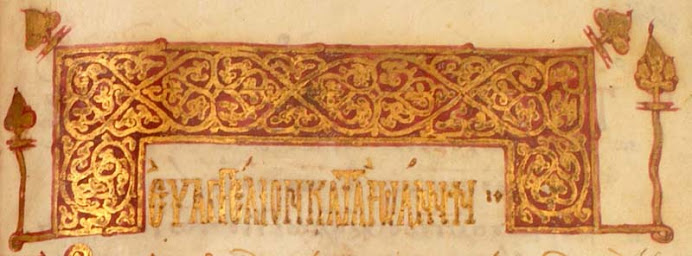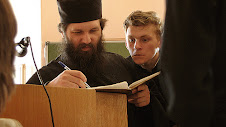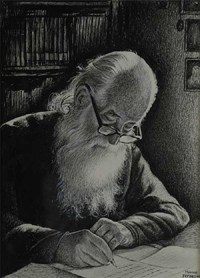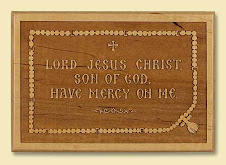 Today is the Sunday of Orthodoxy, on which we commemorate the final restoration of the Holy Icons, and of the Church's conquest over heresy in general. Today's Gospel reading about the calling of Nathanael (John 1:43-51) may at first sight appear to have little to do with this commemoration. Bishop Atanasije offers an explanation of the connection in a sermon given precisely one year ago:
Today is the Sunday of Orthodoxy, on which we commemorate the final restoration of the Holy Icons, and of the Church's conquest over heresy in general. Today's Gospel reading about the calling of Nathanael (John 1:43-51) may at first sight appear to have little to do with this commemoration. Bishop Atanasije offers an explanation of the connection in a sermon given precisely one year ago:God created man in the image of His Son so that, at the time of Christ’s incarnation, the Son of God could become man, assume the image of man, and reveal the dimensions and ranges of the human image, so that man could become God-like, Christ-like, Trinity-like. This is what Philip was saying to Nathaniel when he said, Come and see. Nathaniel went, and the Lord helped him to open his heart further, and that is when he recognized the Son of God in Him, in that “son of Joseph,” as He was regarded. Among the Jews, it was mandatory that a girl not remain unmarried. But, because the Holy Virgin Mary had vowed her virginity to God, the high priest of the time gave her to Joseph, as his betrothed, so that under the guise of marriage her secret could be kept –the secret being that from her, by the Holy Spirit, that is, by God Himself, the New Adam would be born, just as Adam was born in the beginning without a woman. Birth from a woman, that is, the normal human kind of birth, is not the only kind of birth. God can, as He said, of these stones raise up children of Abraham (Mt. 3:9). But God arranged it so that people would be born of Adam and Eve. Christ also followed that human path by becoming man: He went through the womb of the virgin-mother, and his father was the Heavenly Father. And He was born as the true Son of God and Son of Man, the one and only Christ, the eternal Representation, the Image of the True and Living God, the Image of the invisible God (Col. 1:15). He has now become the true image, the face, the icon of man; that is to say, the Original of our image has revealed Himself, the Prototype of Man. This is what we celebrate today, on the Sunday of Orthodoxy.He later adds how we can recognize our own Orthodoxy by venerating our Prototype:
When we leave at the end of the Divine Service, having partaken of Communion, to walk around the church and carry the Holy Icons and sing, We venerate Thy Holy Image, Thy Icon, O Lord, let us also ask this of the Lord: Show us, O Lord, as Thou hast shown Nathaniel, Thy Divine Image in ourselves and in our brethren, so that we may observe Thy Prototype, which is ours, given to us and conveyed to us. Then may we know by this that we are Orthodox. I repeat, Orthodoxy is not a big organization, a mighty force. You will hear many people ask: “What is the Church doing?” I say: “It is doing nothing, but it serves Divine Liturgy.” This was also said by a Russian priest at a meeting in Europe, when Russians were first allowed to leave the country after Stalin’s horrific persecutions. He and others were met by Protestants, Catholics, the organizers of the meeting, and they asked him: “What is the Russian Church doing? What mission does it have in Russia today?” And the priest said: We serve the Liturgy! Others laughed, not understanding that this is the greatest work that can be accomplished in this world and in this history, behind which is God’s Eternity.These words of an anonymous and much-suffering Russian priest are, to me, the perfect response to anyone questioning the "relevance" of Orthodoxy: We serve the Liturgy! This also reminds me of Bishop Nikolai Velimirovic's imagined exchange, cited earlier, between Tolstoy and the Synod who had anathematized him:
"My understanding is against your traditions," said Tolstoi.If nothing else, the Sunday of Orthodoxy should teach us that there is no reason we should feel that we must be forever on the defensive. The Church, after all, is the pillar and ground of Truth (I Tim 3:15).
"Our traditions are against your understandings," replied the Holy Synod.
St Theophan the Recluse, writing at a time when the Rite of Orthodoxy was under much criticism among the Russian intelligentsia, observes why its Anathemas are not only necessary, but indeed acts of love:
Does the holy Church really err in judging them, binding them, and casting them out? And would it really be love for man if she regarded the actions of such people with indifference and left them at liberty to destroy everyone else? Would a mother permit a snake to freely crawl up to and bite her little child, who does not understand the danger? If some immoral person were to gain access to your family and begin tempting your daughter, or your son -- would you be able to regard their actions and their speeches with indifference? Fearing to gain a reputation for being inhumane and old- fashioned, would you tie your own hands? Would you not push such a person out the door and close it against them forever?! You should view the actions of the holy Church in the same way. She sees that individuals of corrupt mind appear, and corrupt others -- and she rises up against them, drives them away, and calls out to all those who are her own: Beware -- so-and-so and such-and-such people wish to destroy your souls. Do not listen to them; flee from them. Thus she fulfills the duty of motherly love, and therefore acts lovingly -- or as you put it, humanely.
At the present time, we have a proliferation of nihilists, spiritists and other pernicious clever ones who are carried away with the false teachers of the West. Do you really think that our holy Church would keep silence and not raise her voice to condemn and anathematize them, if their destructive teachings were something new? By no means. A council would be held, and in council all of them with their teachings would be given over to anathema, and to the current Rite of Orthodoxy there would be appended an additional item: To Feuerbach, Buchner, and Renan, to the spiritists, and to all their followers -- to the nihilists - - be anathema. But there is no need for such a council, and there is no need either for such an addition. Their false teachings have already all been anathematized in advance in those points where anathema is pronounced to those who deny the existence of God, the spirituality and immortality of the soul, the teachings concerning the all-holy Trinity and concerning the divinity of our Lord Jesus Christ. Do you not see with what wisdom and foresight the holy Church acts when she makes us perform the present proclamation and listen to it? And yet they say, "This is outdated." It is precisely now that it is relevant. Perhaps 100 years ago it was not relevant. But one must say concerning our time, that if a Rite of Orthodoxy did not as yet exist, it would be needful to introduce one, and to perform it not only in the capital cities but in all places and in all churches: in order to collect all the evil teachings opposed to the Word of God, and to make them known to all, in order that all might know what they need to beware of and what kind of teachings to avoid. Many are corrupted in mind solely due to ignorance, whereas a public condemnation of ruinous teachings would save them from perdition.
If there were no Rite of Orthodoxy we would need to introduce one! The Rite of Orthodoxy, with its thundering Anathemas is not only not a disturbing leftover from the past, but a test and reminder of our own Orthodoxy.
I haven't much time to write more today, so I'll leave you with some valuable links:
- Services for the Sunday of Orthodoxy: Vespers, Synodikon, Canon of the Synodikon.
- Audio (in Slavonic) of the late Protodeacon Nikolai Porshnikoff reading part of the Rite of Orthodoxy. This thundering reading should curl the toes of anyone who has ever harbored an heretical thought. The full Rite (also in Slavonic), as performed at Holy Trinity Monastery in Jordanville, NY, last year, can be heard here.
- On the Holy Icons, by St Gregory Palamas.
- A sermon given by St Tikhon, later Patriarch of Moscow, in San Francisco, on the Sunday of Orthodoxy, 1903.
- The Sunday of Orthodoxy of and the Current State of Affairs by Photios Kontoglou.
- A sermon on the Sunday of Orthodoxy by Fr Alexander Schmemann.
- Finally, you might think of looking at some of my older posts: Why Do We Venerate Icons?, The Flesh Became the Word, and The Icon and the Image.
What God is as great as our God? Thou art God Who workest wonders! (Ps. 76:14-15)









9 comments:
St Theophan the Recluse, writing at a time when the Rite of Orthodoxy was under much criticism among the Russian intelligentsia...
Do you think, Father, that this criticism lies behind the decision of the Holy Governing Synod of the Russian Church to order the Molieben for the Conversion of those Who Have Departed into Error to be sung in parishes in place of the Rite of Orthodoxy (which was reserved, I believe, to Bishops)?
Interestingly, in our Serbian Ustav (and also among the Greeks who use the Constantinopolitan form of the Rite of Orthodoxy, as opposed to the Alexandrian-Jerusalemite form enshrined in the Greek Triodion) the anathemas are not proclaimed unless a Bishop is present, and only a short selection from the Synodikon is read in that case at the end of the procession around the Church.
I'll reply in more detail tomorrow. For the moment I can only mention that Professor Vera Shevzov of Smith College has given a number of papers regarding the question of the Rite of Orthodoxy in pre-Revolutionary Russia. See here, for instance: http://www.hts.edu/seminary/news/shevzov.html
I don't know if she's published any version of the paper, but she's the person to ask. Send her an email, and she'll likely reply.
In ROCOR practice the Rite of Orthodoxy is performed only with a bishop present. There is an abbreviated Rite served without a Bishop that's become popular in Russia (served, I think, with the blessing of the local bishop). I can look it up tomorrow in the yearly ustav printed in Moscow.
To get an idea of the full Rite as served in ROCOR cathedrals, see the link in the original post. I've heard that it was Archbishop Averky who was responsible for reestablishing its usage. So far as I know, the OCA has no official version of the Rite, but I may be mistaken. Dr Shevzov is the expert here.
More when I have a chance...
By the way, is your parish served by Archimandrite Andrei, a Serb? I had a few talks with him a couple of years back.
Many thanks for your initial comments, and eagerly await to read more later on. Thanks also for referencing the work of Dr. Shevzov on this subject; never in my wildest dreams would I have imagined that such an expert existed!
I have actually seen the Rite of Orthodoxy done once before at the Chicago Cathedral, served by Archbishop Alypy a few years before his accident. It was an impressive and overwhelming thing indeed, even though I knew absolutely no Slavonic at the time.
And yes, Archimandrite Andrija is one of our two priests here in the only Orthodox parish in Puerto Rico. Were you perhaps in Jordanville two years ago, when Father visited there (incidentally, on the Sunday of Orthodoxy)?
Esteban:
I've had a look at the link you kindly sent (I had never seen it before). I think it very unlikely that this moleben was introduced in order to deflect criticism of the Rite of Orthodoxy.
From what I recall from Dr Shevzov's talk, the controversy regarding the Rite played itself out largely in the press: "liberals" attacked it as being antiquated and even insulting, and the Church responded quite vigorously in defense. I can't imagine that the latter would have reacted to this criticism by backing down.
My guess is that the moleben was introduced precisely because the Rite could only be served in the presence of the local bishop. (It's interesting to note that it was reprinted by blessing of Archbishop Averky who, from what I've heard, was largely responsible for having the full Rite performed in ROCOR cathedrals. Chances are he re-introduced the Rite and the moleben simultaneously, for use of cathedral and parish, respectively.)
I'll pick up my copy of the ustav later today, and get back to you.
And, yes, I did meet Fr Andrija at the time and place you mention. He'll remember me as the youngish redhead who pestered him with questions about doctoral programs!
I had a look in the 2008 edition of the Bogosluzhebnye ukazaniia, and found that the Posledovanie Nedeli Pravosalviia contains the entire Moleben you cited, plus additional material. Added are the following, with the deacon standing on the south side of the ambon, facing the people:
-- Deacon: The prokemen "What God is as great as our God..."; "Pravoslaviia den' prazdniushe..." etc.; the Creed, "Ciia vera apostol'skaia, etc.; then a series of "Eternal memories," then a series of "Many years.
-- Priest reads a prayer "Sviataia Troitse..."; "Slava tebe..."
-- Choir: sings the hymn of St Ambrose of Milan, during which time the faithful venerate the icons that have been placed in the middle of the church.
The book notes that this service has been adapted to use by a priest, and gives these two references:
1. Chinovnik arkhiereiskogo sviashenno-clusheniia, part 2, pp. 71-79.
2. Hastol'naia kniga sviashchennosluzhitelia, vol. 4, pp. 534-536.
I may be mistaken, but I think the latter doesn't refer to Bulgakov, but to a series of volumes printed in the 20th century. In any case, one could check Bulgakov and see if the page numbers correspond.
Thanks for your thoughts on this matter, and for even doing some looking around!
I've always been intrigued about the origins and purpose of this Molieben, which is unparalleled in the use of the other Orthodox Churches (but then, Russian practice does seem to have its share of peculiarities). I haven't had a chance to email Dr Shevzov to further inquire about this matter, but if should receive a response from her, I will be sure to pass any enlightening information on to you.
The order you quote from the Moscow rubrics is very interesting; it seems like a "procesionless" and slightly reorganized form of the Alexandrian-Jerusalemite order found in the Greek Triodion (with the Te Deum attached, of course!). If you wish, I can send you the order of the Rite of Orthodoxy as we did it here last Sunday, which I prepared according to the Serbian Ustav. If you're interested, you may drop me a line at my yahoo.com address, which is voxstefani.
I'm quite certain, too, that the Nastol'naya kniga mentioned in the rubrics is not Bulgakov, which is printed in a single volume and whose standard reference is 2nd ed., Kharkov, 1900. I believe the volumes mentioned are a series printed in Moscow with a starting date of 1977.
P.S.: Father Andrija says he remembers you well, and sends his greetings.
Esteban:
Many thanks for your further comment. I've added an email address on my profile page; I'd be very grateful if you could send me a copy of the service you mention.
Incidentally, if I recall correctly the Nastol'naya Kniga was originally printed in one huge volume (there's a copy in the Jordanville library), but has subsequently always been divided into two books. I don't think I've ever seen the 1977 edition. I only wish they had used a more original title! (Given the limited number of liturgical scholars at the time, I wonder who compiled it. I'm guessing it was someone in Moscow, perhaps affiliated with the Theological Academy there. Any ideas?)
But Father, you must understand that they have used different names! Bulgakov's full title is Nastol'naya Kniga dlya Svyashcheno-Tserkovno-Sluzhiteley, whereas the multi-volume Moscow handbook is entitled Nastol'naya Kniga Svyashchennosluzhitelya. Surely no confusion can arise from the fact that both books are abbreviated with the same short hand! :-)
The Moscow volumes, as I recall, were printed by the Patriarchate and were indeed the work of scholars at the Moscow Theological Academy. (I'm relying on recollections at this point, since I don't own this set of books, and have only seen them on a couple of occasions.) And thanks for letting me know that Bulgakov is also printed in two volumes--I have only ever seen it a single volume. (Did you know, by the way, that an Archpriest of the OCA is slowly translating Bulgakov into English, and making it available online? The text is almost complete by now.)
And I will send the text of the Rite of Orthodoxy forthwith.
Post a Comment